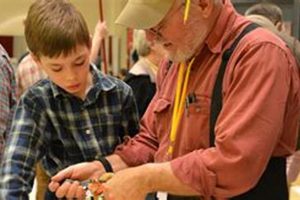An exhibition where artisans and craftspeople specializing in wood-based creations display and sell their works constitutes a significant event for both makers and consumers. Such events typically feature a diverse array of items, ranging from furniture and decorative objects to tools and supplies used in woodworking. These displays offer a platform for artisans to showcase their skills and craftsmanship.
These gatherings are beneficial for several reasons. They provide a concentrated marketplace for woodworking enthusiasts to acquire unique pieces directly from the creators. They offer a learning opportunity for attendees, through demonstrations and interactions with experienced woodworkers. Furthermore, they contribute to the promotion and preservation of woodworking as a traditional craft and a contemporary art form. Historically, these events have served as important venues for networking and the exchange of ideas within the woodworking community.
The subsequent sections will delve into the specific types of woodworking on display, common features of these exhibitions, and the impact they have on local economies and artistic trends.
Tips for Attending a Woodworkers Exhibition
Consider the following guidelines to maximize the benefits derived from attending an artisan woodworking exhibition.
Tip 1: Plan Ahead. Review the exhibitor list and event schedule in advance. Identify specific artisans or demonstrations of interest and prioritize attendance accordingly.
Tip 2: Research Exhibitors. Before attending, consult the websites or online portfolios of participating artisans. This pre-show research can help focus engagement and identify potential acquisitions.
Tip 3: Engage Directly. Initiate conversations with the artisans themselves. Direct interaction provides valuable insight into the creation process, material selection, and artistic inspiration behind the pieces.
Tip 4: Observe Demonstrations. Attend scheduled demonstrations to witness techniques and processes firsthand. This observation offers a practical understanding of the skills involved in woodworking.
Tip 5: Assess Material Quality. Closely examine the materials used in the exhibited pieces. Pay attention to the grain, finish, and joinery to evaluate the overall quality and craftsmanship.
Tip 6: Negotiate Appropriately. If interested in purchasing an item, engage in respectful negotiation with the artisan. Understand the value of handcrafted work and the costs associated with materials and labor.
Tip 7: Document Inspirations. Take photographs or notes of woodworking techniques and designs that resonate. This documentation can serve as a valuable resource for personal projects or future inspiration.
These strategies can significantly enhance the experience and value derived from attending a woodworking exhibition, facilitating both aesthetic appreciation and practical knowledge acquisition.
The article will now proceed to discuss further aspects of these significant events within the woodworking community.
1. Artisan Showcase
The ‘Artisan Showcase’ is a central component of the comprehensive event commonly referred to as a woodworking exhibition. It represents the dedicated area or platform wherein individual craftspeople and studios display their finished pieces. This demonstration of skill and artistry serves as the primary draw for attendees, directly reflecting the quality and diversity of the woodworking community. The success of an exhibition hinges, in large part, on the caliber and presentation of the works within this showcase. For example, prominent shows often feature juried selections, ensuring a baseline level of quality and innovation.
The practical significance of the ‘Artisan Showcase’ extends beyond mere aesthetic appreciation. It provides artisans with a direct opportunity to engage with potential clients, receive feedback on their designs, and generate sales. These interactions are crucial for the sustainability of individual woodworking practices and the overall health of the craft. Furthermore, the showcase serves as a vital educational resource for aspiring woodworkers and design enthusiasts. By examining the techniques, materials, and design choices employed by established artisans, attendees can gain invaluable insights into the art and science of woodworking.
In summary, the ‘Artisan Showcase’ is not merely an ancillary element of a woodworking exhibition; it is the foundational core that defines the event. Its success directly impacts the economic viability of artisans and contributes significantly to the preservation and promotion of woodworking as a respected craft. Understanding this connection is vital for both participants and attendees, ensuring that these exhibitions continue to serve their intended purpose: celebrating and advancing the art of woodworking.
2. Tool Demonstrations
Tool demonstrations represent an integral component of woodworking exhibitions. These presentations offer attendees an opportunity to witness the application of various tools, ranging from traditional hand tools to modern power equipment, in the context of woodworking techniques. These demonstrations provide practical insights into tool functionality and application.
- Efficiency and Precision Enhancement
Demonstrations often highlight how specific tools can improve both the efficiency and precision of woodworking projects. For example, a demonstration of a dovetail jig can illustrate how it enables the creation of precise and consistent dovetail joints, a traditionally challenging technique. Such demonstrations underscore the value of proper tool selection and usage.
- Safety and Best Practices
Tool demonstrations emphasize safety protocols and recommended operational procedures. Presenters routinely highlight the importance of protective equipment, such as eye and ear protection, and demonstrate safe handling techniques. This focus on safety contributes to a culture of responsible woodworking practices.
- Innovation and Technology Adoption
These demonstrations introduce attendees to new woodworking technologies and innovative tools. This exposure to novel equipment fosters technological adoption within the woodworking community. For instance, a demonstration of a CNC router can showcase its capabilities in automating complex cutting operations, potentially influencing artisans to integrate such technology into their workflow.
- Skill Development and Knowledge Transfer
Tool demonstrations contribute to the development of woodworking skills and knowledge transfer. Experienced woodworkers often conduct these sessions, sharing their expertise and answering questions from attendees. This direct interaction facilitates a deeper understanding of tool functionality and application.
These facets of tool demonstrations underscore their vital role in woodworking exhibitions. They not only showcase the capabilities of various tools but also promote safety, innovation, and skill development within the woodworking community. The knowledge acquired from these demonstrations enhances the overall quality and sophistication of woodworking practices.
3. Material Exploration
Within the context of a woodworking exhibition, ‘Material Exploration’ manifests as a multifaceted opportunity for both artisans and attendees. It serves as a platform for showcasing the diverse range of woods, finishes, and related materials utilized in the craft. The availability of different materials directly influences the creative possibilities and technical constraints within woodworking. For artisans, the exhibition offers a chance to display their mastery of particular materials, demonstrating how they can transform raw resources into finished products. For attendees, this exploration fosters a deeper understanding of the qualities, characteristics, and sustainable sourcing practices associated with various materials. For example, a display focusing on reclaimed lumber could highlight the ecological benefits of repurposing wood, while another might demonstrate the unique properties of exotic hardwoods and the ethical considerations surrounding their use.
The inclusion of ‘Material Exploration’ as a dedicated component of a woodworking exhibition significantly enhances its educational value. Demonstrations of different finishing techniques, the presentation of comparative material strength tests, and the discussion of material-specific joinery methods all contribute to a more informed audience. These sessions allow artisans to share their expertise, potentially influencing material choices and practices within the broader woodworking community. Furthermore, the presence of material suppliers and distributors at such events provides opportunities for artisans to source new and innovative materials, fostering experimentation and pushing the boundaries of their craft. The availability of sustainably harvested woods, for instance, allows woodworkers to meet the rising demand for environmentally conscious products.
In summary, ‘Material Exploration’ is integral to a woodworking exhibition, fostering a deeper appreciation for the materials used and promoting informed decision-making within the craft. By showcasing the diverse characteristics of woods, finishes, and related resources, these exhibitions empower artisans to refine their practices and enable attendees to gain a richer understanding of the art and science of woodworking. Challenges associated with ethical sourcing and the long-term sustainability of certain materials are addressed, linking the exhibition to broader conversations about responsible resource management.
4. Community Gathering
The ‘Community Gathering’ aspect of a woodworking exhibition serves as a critical catalyst for fostering collaboration, knowledge exchange, and professional networking within the woodworking community. These shows provide a dedicated space for woodworkers, both amateur and professional, to converge, interact, and collectively strengthen their shared craft.
- Networking Opportunities
Woodworking exhibitions facilitate connections between artisans, suppliers, educators, and potential clients. These interactions lead to new partnerships, collaborations on projects, and the exchange of business opportunities. For example, an artisan may connect with a lumber supplier offering sustainably sourced materials, or a designer may find a skilled woodworker to execute their custom furniture designs. The concentration of professionals in one location creates a valuable networking environment.
- Knowledge Exchange and Skill Development
The informal exchange of knowledge and techniques is a significant benefit of the ‘Community Gathering’. Woodworkers share their experiences, discuss challenges, and offer solutions, leading to skill development and innovation. Demonstrations, workshops, and informal conversations contribute to this knowledge transfer. For instance, a seasoned woodworker may share tips on achieving a specific finish or demonstrate a particular joinery technique to less experienced attendees.
- Industry Trends and Innovations
Exhibitions provide a platform for showcasing industry trends, new technologies, and innovative design concepts. Attendees can observe emerging styles, assess the latest tools and equipment, and gain insights into the direction of the woodworking industry. This exposure to current trends allows woodworkers to adapt their skills and practices to remain competitive. The presence of manufacturers and suppliers further facilitates the dissemination of new products and techniques.
- Support and Camaraderie
Woodworking can be a solitary pursuit. The ‘Community Gathering’ aspect of exhibitions offers a sense of belonging and shared identity. Woodworkers can connect with others who understand their passion and challenges, fostering a supportive and collaborative environment. This camaraderie can be particularly valuable for independent artisans who may lack the social support of a larger organization. The opportunity to share experiences and receive encouragement strengthens the woodworking community as a whole.
These facets of ‘Community Gathering’ are intrinsically linked to the success and vitality of woodworking exhibitions. They provide a crucial platform for networking, knowledge exchange, and the dissemination of industry trends. Ultimately, these events serve as a significant force in strengthening the woodworking community, fostering collaboration, and promoting innovation within the craft.
5. Design Inspiration
Woodworking exhibitions frequently serve as a potent catalyst for design inspiration, influencing both exhibiting artisans and attending patrons. The concentrated display of diverse woodworking styles, techniques, and material applications creates an environment ripe for generating new ideas. The effect of observing meticulously crafted furniture, intricate carvings, and innovative joinery methods often leads to a reevaluation of existing design approaches and the formulation of novel concepts. As a core component of these shows, design inspiration fosters creativity, encouraging artisans to push the boundaries of their craft and inspiring attendees to envision new possibilities for incorporating woodworking into their own projects or living spaces. For instance, an attendee might observe the use of a particular wood grain orientation or finishing technique that inspires them to adapt this concept to their own furniture design, while an artisan could glean ideas from observing the construction methods employed by a competitor, leading to improvements in their own craftsmanship.
The practical significance of recognizing the link between these exhibitions and design inspiration lies in the ability to leverage these events for continuous professional development. Artisans can attend specifically to observe emerging trends, analyze customer preferences, and gather ideas for new product lines. Design professionals, architects, and interior designers can utilize these shows as a resource for identifying unique pieces, understanding the capabilities of various woodworking techniques, and connecting with skilled craftspeople capable of executing custom projects. Furthermore, the educational aspect of these events, through demonstrations and artist talks, often explicitly addresses design principles and their application in woodworking, making this connection even more direct and impactful. An example of this includes observing how a craftsman utilizes negative space in a sculpture, leading to a better incorporation of this design concept in furniture making.
In summary, woodworking exhibitions are not simply marketplaces for finished products; they are vibrant hubs for design inspiration. This crucial element fuels creativity, promotes innovation, and contributes to the ongoing evolution of woodworking as a both practical skill and a creative art form. Recognizing and actively cultivating design inspiration at these events empowers artisans to refine their craft, enriches the creative process for designers, and promotes a deeper appreciation for the artistry of woodworking within the broader community. The challenge lies in translating this inspiration into tangible outcomes, requiring both technical skill and a clear understanding of design principles.
Frequently Asked Questions About Woodworkers Shows
This section addresses common inquiries regarding exhibitions dedicated to woodworking. It aims to provide clarity on various aspects of these events, from their purpose to their value for both artisans and attendees.
Question 1: What is the primary purpose of a woodworkers show?
The primary purpose is to provide a dedicated venue for artisans specializing in woodworking to showcase their skills, connect with potential clients, and engage with the broader woodworking community. Simultaneously, attendees gain access to a wide array of handcrafted items and opportunities for learning and inspiration.
Question 2: Who typically attends a woodworkers show?
Attendance typically includes professional and amateur woodworkers, furniture designers, interior decorators, collectors of handcrafted art, and individuals with a general interest in woodworking and related crafts.
Question 3: What types of items are commonly exhibited at a woodworkers show?
Exhibits typically include furniture, decorative objects, sculptures, turned wood pieces, wooden toys, musical instruments, and a variety of other handcrafted items made primarily from wood. Displays of woodworking tools and supplies are also common.
Question 4: What are the benefits of attending a woodworkers show for an artisan?
For artisans, benefits include increased exposure to potential clients, direct sales opportunities, networking with other professionals, receiving feedback on their work, and staying current with industry trends and innovations.
Question 5: How can attending a woodworkers show benefit someone who is new to woodworking?
Newcomers can benefit by observing demonstrations, learning about different techniques and materials, gaining inspiration for personal projects, and connecting with experienced woodworkers for guidance and mentorship.
Question 6: Are there typically opportunities to purchase items directly from artisans at a woodworkers show?
Yes, direct purchase opportunities are a key feature of these shows. Attendees can typically buy items directly from the artisans who created them, offering a unique opportunity to acquire handcrafted pieces and support local craftspeople.
In essence, woodworkers shows serve as a vital link between creators and consumers, fostering a vibrant community and promoting the appreciation of woodworking as both a traditional craft and a contemporary art form.
The subsequent section will explore further aspects related to the organization and impact of woodworkers shows.
Conclusion
The preceding analysis has detailed the multifaceted nature of the woodworking exhibition. Examination included the artisan showcase, tool demonstrations, material exploration, community gathering, and design inspiration, each component contributing to the event’s overall value and impact. These events serve as critical hubs for promoting craftsmanship, fostering innovation, and sustaining the woodworking community.
Continued support for these events is essential to maintain the vitality of woodworking as a respected craft and artistic endeavor. The exhibitions represent a confluence of skill, creativity, and economic opportunity, and their ongoing success benefits artisans, consumers, and the broader cultural landscape. Further research and investment in these events can enhance their reach and impact, ensuring a thriving future for the woodworking community.







